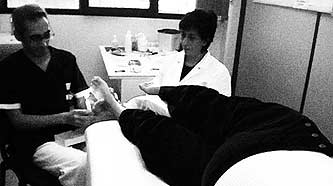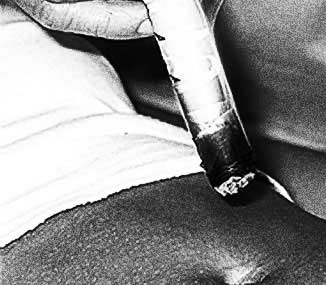Moxibustion, to correct a breech presentation of the fetus
Results
Since the early 1990s, studies have been carried out in China documenting the effectiveness of moxibustion in correcting a malpositioning of the fetus (Li et al. 1990; Li et al. 1996).
The first randomised controlled study was conducted by Cardini and Weixin in 1998, on 260 women with breech presentations in the 33rd week of gestation.
Half of the women were treated with stimulation of acupoint BL67, with an artemisia stick placed close to the skin for about 15 minutes. The treatment was given once or twice a day for seven days. This stimulation increased fetal activity (48 against 35 movements an hour). By the 35th week, 75% of the babies treated with moxibustion had turned, while only 48% of the control group had done so.
If in the 35th week, the babies were still in the breech position, the women in both groups could choose to undergo external cephalic version (ECV) which led to a further 19 babies turning round. The newborns from the treatment group had an Apgar rating at birth that was significantly better than those in the control group. On the basis of these data, the authors concluded that moxibustion between the 33rd and the 35th week of gestation, followed by ECV in the 35th week if the baby remained in the breech position, is an effective approach to correcting a breech presentation of the fetus.
In 2001 Kanakura Y.et al. conducted a similar study on a group of 357 women of whom 224 made up the control group and 133 the group to be treated by moxibustion. The fetus turned in 92.48% of the treated group, and in 73.66% of the control group. This was a significant difference (P<0.0001, x 2 tests).
On the basis of these encouraging results, some clinical trials began in Italy and other European countries to confirm the efficacy of treatment with moxa to correct a breech presentation of the fetus.
At the Centre for Traditional Chinese Medicine of the Florence Health Service, in collaboration with the Regional Health Agency for the Tuscany Region and the Florence Hospital Service, in the period 1997-2001 a pilot study was carried out (in the consecutive observation mode) on 189 women with a breech presentation and gestational age of between the 32nd and 37th week. The women came forward for treatment voluntarily or were invited to do so by health personnel.
The importance of this study lies in the fact that it was the first of its kind to be carried out in the West and it used a fairly large sample of patients. Recruitment of the patients was achieved by systematically offering the treatment to women who met the protocol conditions.
The technique employed consisted in a first cycle of bilateral stimulation (from one to three times during one week, according to result) of acupoint BL67 with an 0.32 x 0.40 needle heated with a candle. In the case of a negative result, demonstrated by ultrasound scan, a second treatment cycle was carried out (from one to three times during one week, according to result) heating the same acupoint with an artemisia stick . Stimulation was carried out by trained personnel at the Centre.
Prior to each treatment session, the position of the fetus was determined by a manual examination of the abdomen and the fetal heartbeat was monitored with a Multidoppler machine (model: ES-107 PZ Hadeco).
Treatment was completed when the cephalic position was achieved, demonstrated by an ultrasound scan, or after six sessions with no success. The result was evaluated on the basis of the last ultrasound scan and presentation at birth.
The sample comprised 125 nulliparas (88% Italians, 4% Chinese and 8% of other nationalities) and 64 primi-multiparas (75% Italians, 14.1% Chinese and 10.9% of other nationalities) with an average age, respectively, of 31 years (DS 4.6) and 33 (DS 4.0).
Cephalic version was obtained in 106 women (56.1%) with a greater degree of effectiveness in the primi-pluriparas (75%) than in the nulliparas (46.4%), in line with other studies on the subject. When treatment was carried out in the 32nd–34th week the fetus turned in 68% of cases, while between the 35th and the 37th week the result was 41%.
In all cases but three, the cephalic position was maintained up to delivery. External cephalic version was practised on 22 women and was successful in 14, while in 8 cases, the fetus remained in the breech position. Comparing the success obtained in the group of nulliparas and primi-multiparas women, in the latter, the success rate was five times higher. If the mother is aged under 34 years and this treatment is given before the end of the 34th week, there is a significantly increased possibility that the fetus will turn into the cephalic position. The results of this study are currently being prepared for publication.
The team at the S. Martino Gynaecology and Obstetrics Clinic in Genoa have also published some data showing that the technique was successful in 60% of cases receiving this treatment.
In Belluno the study group of the Feltre Civil Hospital showed a substantial difference in the turning rate for primagravidas treated with moxa: 54.5% compared with the untreated control group’s 28.5%.
In Turin, a randomised multicentre trial is currently under way, coordinated by the Maternal- Fetal Medicine Operating Unit of Turin University.
WARNING
When applying this method, it should be borne in mind that artemisia smoke can create problems for patients with respiratory difficulties. In these cases, special cigars can be used that produce little or no smoke. Recently, it has been reported that, occasionally, there is an increase in uterine contractions after the treatment. Nevertheless, none of the studies published to date has indicated any tendency to premature delivery.
DOWNLOAD THE BROCHURE PDF
albanian (0.7 MB)english (0.4 MB)
spanish (0.4 MB)
serbian (0.9 MB)








 COUNTRY OF ORIGIN
COUNTRY OF ORIGIN